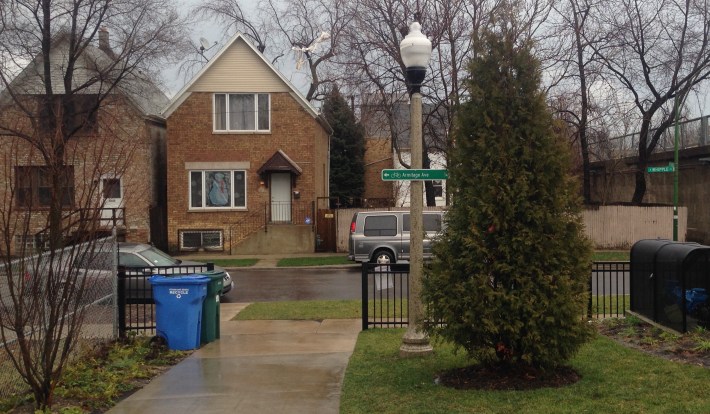
Last month, colorful new wayfinding signs were installed near all of the access ramps for The 606, aka the Bloomingdale Trail. They point trail users to the nearest off-ramp and access park. The relatively small text on the signs is a little tricky to read if you're cycling past them at a moderate pace, but they're a welcome addition to the trail. They'll help people become more familiar with the street names in the four neighborhoods the elevated greenway passes through.
"We asked IDEO [a design company] to design a system that would provide necessary information without cluttering the landscape," said Beth White, regional director at the Trust for Public Land, which is managing outreach and fundraising for the trail. "We think they struck a great balance between the two."
Gap in street-level wayfinding
The new Bloomingdale Trail signage hints at what good wayfinding signs could do for on-street cycling. Prior to the path’s grand opening, the city installed additional bike route signs along nearby streets, telling people the distance and direction to the nearest access ramp.
However, many streets that intersect the trail, like Kimball, which would benefit from wayfinding signs, don't have them. And, currently, some signed bike routes to the trail are counterintuitive and hard to follow.
For example, Kedzie Avenue is a handy way to get to the trail from Logan Square and Humboldt Park, and it has a buffered bike lane. But it's tricky to find your way to the nearest access ramp, located between Albany Avenue and Whipple Street in Julia de Burgos park, due to the proliferation of one-way streets near the park.
If you're pedaling south on Kedzie towards the trail, a bike route sign directs you to turn east onto Cortland Street. The next intersection is Albany, but you can't turn south towards the park there because Albany is one-way northbound. However, there's no signage indicating you need to head another block east to Whipple, which is southbound. It takes less effort and distance to continue south and turn east onto Moffat St. to access the park.
Once you get to Whipple, a sign directs you to head south towards the trail access ramp. But when you arrive at Julia de Burgos Park, there's no curb ramp to allow you to pedal into park.
On-street bike route signs should be placed at regular intervals along the route to confirm that you're still going the right way. Alternatively, the city could use pavement markings like the green sharrows on Wood Street to guide cyclists along the route.
This isn't a unique situation. Ridgeway Avenue is another example and other ramps also drop down to one-way streets where the convenient route is the "wrong-way" route.
Going the wrong direction is something one sign encourages. Coming down the ramp at Julia de Burgos park, riders who go right towards Whipple encounter a sign saying Armitage Ave. is 1/4 mile to the left – and left here means riding northbound against one-way southbound traffic.

In many European cities, it's legal for cyclists to ride in both directions on streets that have been designated as one-ways for motorists. That's one reason cycling is so convenient in these cities. While a few Chicago streets, like Wood, Berteau St., and Albion Ave., currently have contra-flow bike lanes, this approach should be considered for many more streets.
Mike Claffey, spokesperson for the Chicago Department of Transportation, which built The 606 and installed the signs for the on-street bike routes, said CDOT is "currently in the process of reviewing bike and pedestrian access and wayfinding signage at all ramps and will develop recommendations for improvements as part of this process."
The gap of on-street wayfinding signs could be filled in by installing more of the IDEO-designed signs at the bottom of the access ramps. Currently there are few signs telling cyclists who are exiting the trail how to get back to a bike route or a familiar major street. These signs could also be used to promote commerce by directing trail users to neighborhood retail strips.
Cyclists must dismount
One new group of signs that directs people cycling off the Bloomingdale Trail to connecting on-street routes is also perplexing. At the end of the trail in Walsh Park signs point to connections for Damen Ave., Cortland St., and the Lakefront Trail. To get to the street, a bicyclist could head over the sidewalk and parkway and between some parked cars, or go up the sidewalk to the alley.

A "no cycling on the sidewalk" sign tells people to get off their bikes, though. A similar situation, equally contradictory, was at the 18th Street access point to the Lakefront Trail since it was built 11 years ago. The Chicago Department of Transportation built an access ramp this year so people on wheels didn't have to ride on the sidewalk.
Claffey said, "We are looking at spot-specific issues (e.g. new curb cuts) as well as neighborhood connectivity issues (e.g. signage, etc.)" and that Walsh Park is one area CDOT is looking at. The Bloomingdale Trail has only been open for a lively six months, but modifying these spots next year would ensure neighborhood cycling trips are a comfy, one-seat ride.
Streetsblog Chicago will resume publication on Monday. Have a great holiday!
![]()
Did you appreciate this post? Streetsblog Chicago is currently funded until April 2016. Consider making a donation through our PublicGood site to help ensure we can continue to publish next year.



